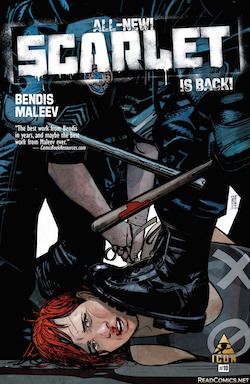Thursday Comics Hangover: Glaciers move faster than this comic book
In 2010 and early 2011, writer Brian Michael Bendis and his frequent collaborator, artist Alex Maleev, published the first five issues of a comic titled Scarlet. Bendis and Maleev have always been ideal collaborators: something about Bendis’s propensity for including too much Mamet-style dialogue on every page works well with Maleev’s photorealism, which often fails to convey action in any convincing way. Their comics — particularly their long run on Daredevil — tend to be wordy dramas that feel more like plays than the usual action movies you’ll find in superhero comics. They're better together than they are apart.
Scarlet is built on an intriguing premise. Set in Portland, the comic stars a woman named Scarlet Rue who targets the corrupt Portland Police Department in the hopes of starting a revolution. Scarlet frequently breaks the fourth wall to talk to the readers of the comic, and early in the series she promises to use the readers as a part of her plan, somehow. The book read like a cross between Fight Club, Occupy Wall Street, and a childrens’ TV show, and those first five issues were fairly vibrant examples of what Bendis could do when he focused his attention on expanding the medium in interesting ways.
Then nothing happened for two years.
In 2013, Maleev and Bendis published the next two issues of Scarlet.
Then nothing happened for three years.

Last month, Bendis and Maleev published the eighth issue of Scarlet, which was immediately followed by the ninth issue of Scarlet. Yesterday, they published the 10th issue. This wraps up the second story arc of the series, which will be collected soon as Scarlet, Book 2. This flurry of publishing came with the news that Scarlet was in development as a TV series for Cinemax. (Generously assuming one episode per published issue of the comic, it’s highly likely that the series will be very loosely based on the book, given that they’ll have to come up with their own stories in less than a single seasons’ worth of shows.)
The 10th issue of Scarlet kicks off with one of the best sequences in the book, a personal account of sexism within the Portland PD that opens up the interior life of a supporting character. The passage is illustrated in a sketchy, almost childlike, style unlike anything else Maleev has done, and it adds to the tremendous sense of stylistic potential that Scarlet has carried with it since the very beginning.
Unfortunately, the story then reverts to form, with Scarlet playing crowds of angry people against the Portland Police Department again — I’ve honestly lost count of how many times variations on this scene have played out, because I haven’t re-read the series in the six years it’s taken these ten issues to be published. And then on the last page of the issue come the words that will make all but the most cynical of readers throw up their hands in defeat: “TO BE CONTINUED…NEXT YEAR.”
Okay. It’s clear that Scarlet is not a money-maker of a series. (In addition to Scarlet, Bendis is also writing two Iron Man series — one of which is illustrated by Maleev — a Spider-Man series, a Guardian of the Galaxy series, and Marvel Comics’ big summer crossover event, Civil War II.) But this publishing schedule is ridiculous. There’s no point in publishing a story in individual issues like this if a reader could earn a graduate degree in the amount of time it takes for two full chapters to dribble out in ten comics. If the book is a labor of love for the two creators, why not just publish Scarlet in collected form? As it is, Maleev and Bendis are just frustrating the few loyal fans they have left with this erratic publication schedule and squandering the considerable good will they built with those striking first issues.